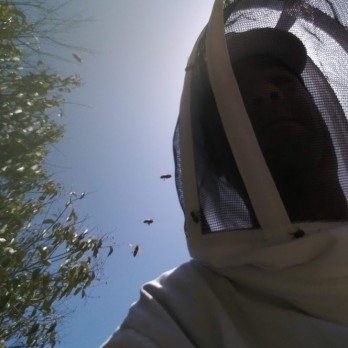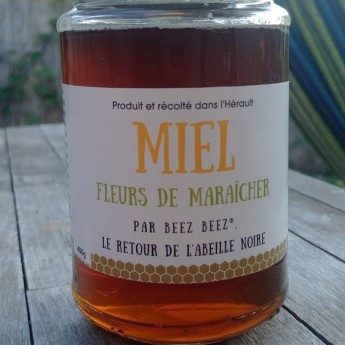
Hello! How to start your own beehive is the first in the series of interviews with inspirational ‘eco warriors’. I realised there are so many of them among my friends, colleagues and family. And this is their time to shine and encourage others!

Hands up who likes honey?! But will it soon become a delicacy from the past? We have all seen upsetting headlines about honeybees dying across the world. Is there something that can be done at a grassroots level? Meet Kevin, a friend, who started his own beehive to support the environment.
Why did you set up your own bee hive?
It’s been a while since I’m very aware of the environmental crisis. The topic of climate change is particularly close to my heart and is one of the reasons why I work in the renewable energy sector. That’s why I also became interested in biodiversity and the role of bees and the very sad topic of their decline. I wanted to take my own ‘green step’ specifically to help the black honeybees, one of the endemic species, currently on the brink of extinction. And I also love honey – such a delicious and natural product.
How did you make it happen?
First I launched a crowdfunding campaign on Ulule. The goal was to get the necessary funds but it was also my way to raise awareness. And it worked really well! I was touched by the fact that it was not only friends and family who supported me but also individuals who have never met but wanted to support my cause. This added a bit of a pressure but also motivation.
The funds I raised allowed me to buy the equipment, which in itself was a steep learning curve in terms of what to buy and where from. But the key challenge was how to find the honeybees and the ultimate location for my beehive.
What about maintenance?
The busiest season for beekeepers is between April and July. This is the time when:

- the honeybee colonies grow bigger
- we start harvesting honey
- then we put it into pots
- and we treat colonies with anti varroa treatment (varroa mites attack and feed on the honeybees)
During the season I visit my beehive once a week. But in winter honeybees stay inside or leave the hive very infrequently. This is the perfect moment for bee keepers to get ready for the next honey season avoiding temptation to open the hive lid to check what is happening inside.
What was your key challenge?
There have been so many aspects I had to figure out when I was learning about beekeeping. It’s a very unique profession where you ‘work with’ living creatures while they’re interacting with their own habitat. And the more you discover the more questions come to mind. I am sure that if you asked each beekeeper 10 questions they would give you 10 different answers. That’s why it is crucial to come up with your own best practice based on solid knowledge. The diversity of the apiculture (beekeeping) practice can sometimes be puzzling!
What about the best aspect?

Healthy bees and deliciously tasting honey!
The cause and the taste are so good.
Tell us about surprising or interesting facts about bees
A worker bee lives between 2 to 6 months depending on the season. The queen bee, however, can live up to 5 years. And the key difference between the worker and the queen is the fact that at the larvae stage the queen was fed with a royal jelly. I find it fascinating!
Another interesting point is around the diversity of bee species. To boost productivity, many different bees have been imported from across the world and therefore from other biotopes. This is one of the reasons why the endemic bee of western Europe, the black bee (Apis Mellifera Mellifera) present for millions of years, is today on the verge of extinction, while it is the most suitable to our habitat. It’s a man made ecological disaster and biodiversity loss. While it’s a common knowledge in beekeeping, there is very little awareness amongst consumers.
Bees are dying across the world. Have you encountered similar problems?
Unfortunately, yes. It’s a real challenge for beekeepers. We lose on average 30% of colonies each year. It’s so upsetting to find an empty hive or dead bees. Especially that we never really know what caused it.
In my case, I think the varroa mites were the culprits. They weakened my colonies by feeding on the “blood” of bees (adults and larvae). This meant that they were no longer able to lead the colony or to defend themselves. The Asian hornets (which feed on bees) then literally assaulted the weak colonies.
To finish, could you advise my readers on how to start a beehive in 5 steps?
- Start with a solid apiculture training course to gain knowledge and necessary skills.
- Decide on what type of beekeeping you’re interested in.
- Now location of your beehive. Can you place it in your or garden or do you need to look somewhere else.
- Don’t forget about your protective equipment. I had a few unpleasant episodes simply due to lack of sufficient care. Disturbing colonies can be very dangerous. Bees simply defend themselves.
- Don’t forget to enjoy yourself while remaining humble. There are so many external factors that can play part in your beekeeping activity. It doesn’t always turn out the way you’d planned it!
Thank you so much Kevin!
Learn more about climate change facts and disappearing wildlife.
Photos used in this article thanks to Kevin Mozas.

5 thoughts on “How to start you own beehive – interview”